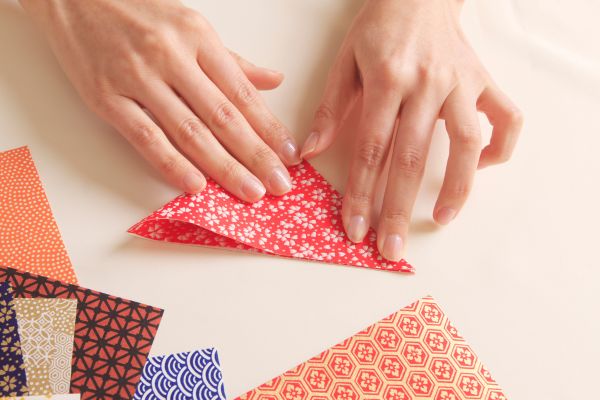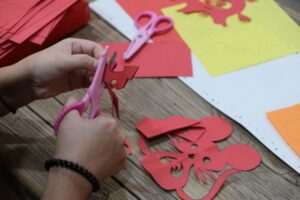Origami, the Japanese art of paper folding, has captivated hearts and minds around the world for centuries. Rooted in Japanese culture, this ancient craft combines creativity, precision, and cultural symbolism. In this article, we will explore the art of origami, its historical origins, traditional techniques, and its enduring cultural significance in Japan.
1: The Origins of Origami: Ancient Beginnings
1.1 Ancient Paper in Japan: A Precious Material
The art of origami traces its roots back to ancient Japan, where paper was introduced from China during the 6th century. In a society that highly valued the written word and paper as a symbol of knowledge and status, the art of folding paper soon emerged as a form of artistic expression.
1.2 The Role of Buddhist Monks: Early Practitioners of Origami
Buddhist monks played a significant role in the development of origami. They used paper folding as a meditative practice and incorporated folded paper figures into religious rituals. These early practitioners contributed to the evolution of origami techniques and passed down their knowledge through generations.
1.3 Traditional Paper Folding Techniques: Simplicity and Elegance
Origami in its earliest form focused on simple and elegant designs. The art emphasized the beauty of creating intricate forms through precise folds, without the use of cutting or adhesive. This approach reflected the Japanese aesthetic principles of simplicity, harmony, and appreciation for natural forms.
2: The Symbolism of Origami in Japanese Culture
2.1 The Crane: Symbol of Longevity and Good Fortune
The origami crane, or “orizuru,” holds a special place in Japanese culture. It is believed that folding 1,000 paper cranes can grant a wish or bring good luck and longevity. The crane symbolizes hope, resilience, and peace, and it is often folded and gifted during significant life events, such as weddings and newborn celebrations.
2.2 The Samurai Helmet: Courage and Warrior Spirit
Origami samurai helmets, also known as “kabuto,” are folded to honor the bravery and noble spirit of the ancient Japanese warriors. These intricate paper creations represent courage, strength, and protection, and they are often displayed as decorative items or used as props in traditional theater performances.
2.3 The Mount Fuji: Icon of Japanese Identity
The iconic Mount Fuji, Japan’s highest mountain, is a popular subject in origami. Folding a paper representation of Mount Fuji symbolizes the deep connection between the Japanese people and their natural surroundings. It embodies the beauty, serenity, and enduring spirit of the Japanese landscape.
3: Traditional Origami Techniques and Styles
3.1 The Waterbomb Base: Foundation for Many Designs
The waterbomb base is a fundamental origami fold that serves as the starting point for numerous origami creations. This versatile fold allows for the creation of geometric forms, such as boxes, cubes, and polyhedra. It is an essential technique that provides a strong foundation for advanced origami designs.
3.2 The Crane Base: Building Block for Figurative Origami
The crane base, also known as the bird base, is a foundational fold used to create origami figures, including birds, animals, and humanoid shapes. This fold serves as a starting point for many figurative origami designs and provides the structure necessary for creating detailed and expressive paper sculptures.
3.3 Modular Origami: Connecting Units for Intricate Designs
Modular origami involves creating complex designs by assembling multiple units of folded paper. These units interlock to form intricate patterns and three-dimensional structures. This technique allows for the creation of large-scale origami artworks, including geometric shapes, flowers, and architectural models.
4: Origami in Modern Times: Creativity and Innovation
4.1 Tessellations: Repeating Patterns and Mathematical Beauty
Tessellation is a contemporary origami technique that explores the repetition of geometric shapes to create intricate and visually striking patterns. This fusion of art and mathematics showcases the endless possibilities of origami as a creative and intellectual pursuit.
4.2 Origami in Science and Technology: Folded Solutions
Origami has found practical applications in various fields of science and technology. Engineers and designers have drawn inspiration from origami’s folding principles to develop solutions for space exploration, medical devices, solar panels, and even self-assembling structures. Origami’s ability to transform two-dimensional sheets into complex three-dimensional objects has opened new frontiers in innovation.
4.3 Origami as a Therapeutic Art: Mindfulness and Relaxation
Origami has been embraced as a therapeutic art form, providing a calming and meditative practice for individuals seeking relaxation and mindfulness. The focus required in precise folding, the rhythmic repetition, and the satisfaction of completing a folded creation contribute to a sense of tranquility and inner peace.
5: Origami as an Educational Tool: Learning through Folding
5.1 Origami in Schools: Enhancing Learning and Creativity
Origami has found its way into educational settings as a valuable tool for teaching various subjects. It promotes spatial reasoning, problem-solving skills, and fine motor development. Folding paper into various shapes and figures engages students in a hands-on and visually stimulating learning experience.
5.2 Math and Geometry: Exploring Mathematical Concepts with Origami
Origami offers a unique way to explore mathematical concepts, such as symmetry, fractions, and geometry. By folding and manipulating paper, students can visualize and understand abstract mathematical principles, making learning more tangible and engaging.
5.3 Origami in STEAM Education: Integrating Art and Science
In STEAM (Science, Technology, Engineering, Art, and Math) education, origami serves as a bridge between artistic expression and scientific inquiry. Through origami projects, students can explore concepts like structural engineering, material properties, and biomimicry, fostering interdisciplinary learning and innovation.
6: Origami in Popular Culture: From Movies to Fashion
6.1 Origami in Film: Symbolism and Storytelling
Origami has made appearances in numerous films, adding depth and symbolism to storytelling. Whether it’s folding paper cranes as symbols of hope or intricate origami figures representing characters’ journeys, these cinematic moments showcase the art’s ability to convey emotions and enrich narratives.
6.2 Origami in Fashion and Design: Folding Fabrics and Structures
Origami’s influence extends to the world of fashion and design, where designers incorporate folded fabric techniques and origami-inspired structures into garments, accessories, and architectural designs. The art’s emphasis on shape, structure, and geometric precision brings a unique aesthetic to the fashion industry.
6.3 Origami in Contemporary Art: Pushing Boundaries and Conceptual Exploration
Origami has been embraced by contemporary artists as a medium for conceptual exploration and boundary-pushing. Artists create installations, sculptures, and mixed-media artworks that incorporate origami techniques, blurring the lines between traditional craft and contemporary art forms.
7: Origami as a Global Phenomenon: Cultural Exchange and Adaptation
7.1 International Origami Organizations: Connecting the Global Community
Origami has gained a global following, and international organizations have emerged to connect enthusiasts, foster collaborations, and promote the art form worldwide. These organizations organize conventions, workshops, and exhibitions, facilitating cultural exchange and celebrating the diversity of origami practices.
7.2 Cultural Adaptation: Origami in Different Countries and Traditions
Origami has been embraced and adapted by various cultures, each bringing its own unique style and interpretation to the craft. From Chinese paper folding to European origami techniques, these regional variations reflect the universal appeal and adaptability of origami as a creative pursuit.
7.3 Origami as a Symbol of Peace and Unity
Origami has been embraced as a symbol of peace and unity, transcending cultural boundaries. Initiatives such as the Thousand Crane Project, inspired by the story of Sadako Sasaki, promote peace and harmony through the collective folding of paper cranes, fostering connections and spreading messages of hope around the world.
8: Origami as a Mindful Practice: Focus and Meditation
8.1 Origami as Mindfulness: Finding Calmness in Folding
Origami provides a mindful practice that encourages focus, concentration, and presence in the moment. The rhythmic folding motions, attention to detail, and the satisfaction of creating something beautiful foster a sense of tranquility and inner peace.
8.2 Origami and Meditation: Combining Art and Mindfulness
Origami can be seamlessly integrated with meditation practices, offering a form of moving meditation. By combining the intentional folding of paper with mindfulness techniques, practitioners can experience a deeper connection to their breath, body, and creative flow.
9: Origami in Contemporary Design: Innovation and Collaboration
9.1 Origami in Architecture: Folded Structures and Sustainable Design
Architects and designers are increasingly incorporating origami principles into their work, exploring folded structures and sustainable design solutions. The adaptability and efficiency of origami-inspired techniques offer new possibilities in creating dynamic spaces, flexible structures, and environmentally conscious designs.
9.2 Origami in Product Design: Folded Forms and Functional Solutions
Origami techniques have influenced product design, inspiring innovative and functional solutions. From collapsible furniture and packaging to folded textiles and accessories, designers leverage the principles of origami to create products that are both aesthetically pleasing and space-efficient.
10: Origami for All Ages: Education and Creativity
10.1 Origami in Early Childhood Education: Developing Fine Motor Skills and Spatial Awareness
Origami is widely recognized as a valuable educational tool for early childhood development. The practice of folding paper enhances fine motor skills, hand-eye coordination, and spatial awareness, while also fostering creativity and imagination in young learners.
10.2 Origami for Seniors: Cognitive Stimulation and Therapeutic Benefits
Origami offers cognitive stimulation and therapeutic benefits for seniors, promoting dexterity, focus, and mental agility. The tactile nature of folding paper provides a soothing and engaging activity that can improve hand strength, memory, and overall well-being.
Conclusion
Origami, with its deep cultural roots, creative expression, and broad applications, continues to captivate individuals across ages, cultures, and disciplines. From its origins in ancient Japan to its modern-day presence as an art form, educational tool, and mindful practice, origami exemplifies the power of human creativity and the universal appeal of the folded paper.
As we explore the art and significance of origami, let us appreciate its ability to inspire, connect, and transform. May origami continue to bring joy, foster learning, and serve as a reminder of the beauty and ingenuity that can emerge from a simple sheet of paper.



